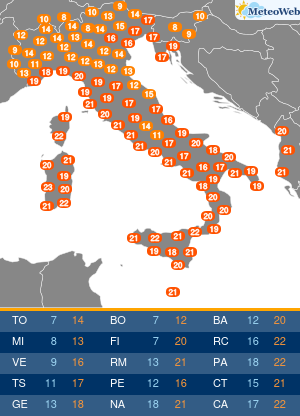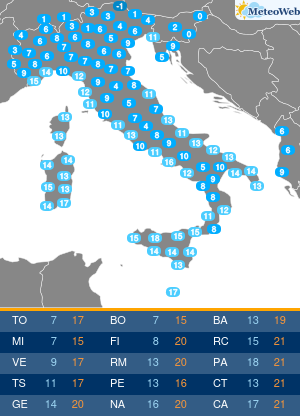Mentre al Sud Italia è tornato il caldo africano e Pantelleria, dopo aver raggiunto i +40°C nel pomeriggio di ieri, vive una notte di paura per gli incendi che hanno portato a massicce evacuazioni via mare, il Nord è alle prese con una intensa ondata di maltempo che ha già provocato gravi danni nelle scorse ore nel cuore della pianura Padana. A Bondeno, nel ferrarese, il vento ha sfiorato i 130km/h come se stesse passando un uragano di 1ª categoria, e la cittadina è in ginocchio per i gravi danni. Intensi nubifragi hanno colpito Biella e l’area del Po al confine tra Lombardia e Veneto, con picchi di 90mm di pioggia.
Eppure tutto questo è soltanto un piccolo antipasto dei fenomeni estremi che colpiranno l’Italia centro-settentrionale nelle prossime ore, in particolare tra la tarda mattinata di Giovedì 18 Agosto e la mattinata di Venerdì 19 Agosto, quando l’ondata calda pre-frontale raggiungerà il suo picco al Sud (attesi picchi di +45°C in Sicilia!), mentre la perturbazione atlantica sprofonderà sul Mediterraneo occidentale generando una pericolosissima linea di demarcazione proprio sul Centro/Nord Italia. E’ altissimo il rischio di tornado distruttivi, piogge alluvionali e grandinate: a confermarlo il consueto bollettino Estofex, che ha lanciato addirittura un allarme di livello viola, il massimo disponibile, “livello 3” come possiamo osservare nelle immagini a corredo dell’articolo. Nel bollettino si parla per il Centro/Nord Italia di rischio elevato di “grandine molto grossa, venti devastanti, piogge eccessive e tornado“.
In coda all’articolo riportiamo il bollettino originale, raramente così estremo e pesante. Per monitorare la situazione meteo in tempo reale, ecco le migliori pagine del nowcasting:

Allerta Meteo, il bollettino Estofex per Giovedì 18 Agosto originale
SYNOPSIS
A deep trough is forecast to move from NE Iberia towards Italy. Between the trough and a ridge stretching from S Italy into the Balkans, a strong mid to upper tropospheric flow is simulated. Abundant low-level moisture combined with steep mid-tropospheric lapse rates advected from Sahara yields very high CAPE values over the central Mediterranean. Towards the E, a shallow mid-tropospheric low remains over S Russia, Ukraine, and the Black Sea. Closer to the surface, an ill-defined frontal boundary will be situated over Germany, S E France, N Italy, and the western Mediterranean.
DISCUSSION
… Balearic Sea through Corsica, Sardegna, Italy into the Adriatic Sea …
An outbreak of (extremely) severe thunderstorms is expected over the area!
An extreme overlap of CAPE and shear is forecast across the area, especially over the seas and the adjacent coastlines. MLCAPE > 3000 J/kg will combine with 0-6 km shear between 25 and 35 m/s and 0-3 km shear between 20 and 30 m/s. Storms forming in this environment will have a high probability to become extremely severe. They will be initiated by the warm air advection in the early morning hours, followed by further initiation along the advancing cold front and ahead of the axis of the trough. The highest coverage is forecast in the late afternoon to early night hours. All models agree on the CAPE-shear overlap and storms being present somewhere within the Lvl 2. Large discrepancies in the presence and timing of storms can be found in convection-allowing models.
Further uncertainties in the forecast are:
1. The southward extent of the morning convection, which will very likely be plentiful near the coastlines of the NW Italy. This may impact where the track of the most intense severe weather will be in the afternoon and evening.2. Convective mode. The whole situation will unfold with a mix of supercells and large convective systems. The exact convective mode over a certain location will determine the main severe weather type. Some of the high-resolution model runs suggest intense bow-echoes capable of extremely severe wind gusts. While this is not a typical evolution over the area, it is plausible given that the lift for storms moves fairly quickly east and that the 0-3 km shear is very favorable for convective windstorms. If supercells form, a threat of 5+ cm hail will be very high. Supercells may become tornadic given strong LLS along the coastlines.
3. How effective will the forcing combined with low-level lapse rates remove the stable layer with large CIN between the moist maritime boundary layer and steep lapse rates aloft? The best agreement in CIN removal among the models is currently for the area W of the Apennines.
Lvl 3 is issued for the area, where the highest confidence in extremely severe weather exists, but any storm forming within Lvl 2 will have a high chance of producing severe weather!










